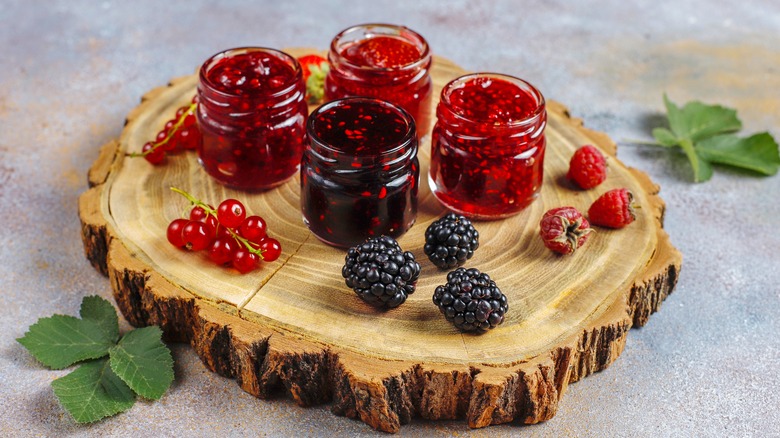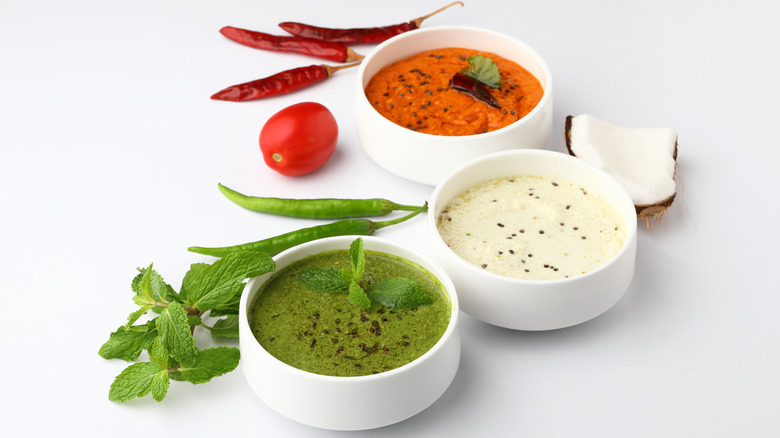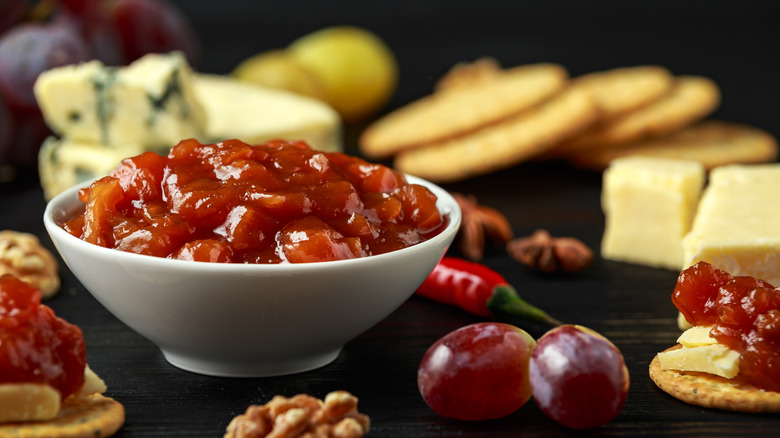The Biggest Difference Between Jam And Chutney
Let's be honest: We've all been guilty of confusing jams, jellies, compotes, preserves, marmalades, and chutneys with one another, wrongly assuming them to be nothing but different names for the same thick fruit spread that you smear onto slices of toast or stuff in between desserts. But no — they are not the same thing, especially not chutney. While the differences between jams, jellies, and the like are more subtle and can be as something as nuanced as the texture of the fruit spreads, chutney happens to be quite different.
Jam is made by cooking fruit with sugar until it softens and breaks down into a thick and often chunky spread. Though chutney too is made from fruits or vegetables and sugar, the most distinguishing factor between the two is the use of acid and spice. While jams contain fruit and sugar along with the occasional added pectin, a warm spice or two, and a splash of lemon juice to balance the sweetness of the jam and help it set nicely, chutneys tend to go heavier on the acid and spice. Unlike the lemon juice that goes into jams, chutneys mostly use vinegar and skip the added pectin. Jams may use cinnamon, star anise, or clove, but chutneys are flavored with a broader variety of spices, including cumin, coriander, turmeric, and even chili and pepper!
Chutneys have less sugar and more spice
The use of vinegar and punchy spices gives chutney a certain savory heat and tang that jam lacks, which is further heightened because it uses less sugar as well. According to the FDA, for a spread to qualify as jam, it should be 45 to 47% fruit (depending on the fruit's type) and 55% sugar. Where this makes sugar a quintessential ingredient in jam — consequently giving it a considerably sweet flavor — it doesn't quite enjoy the same importance in a chutney.
Chutney too has some sugar but its proportion is much lower in comparison to that of jam. Additionally, rather than used to give it a predominantly sweet flavor, the sugar in a chutney works with a mix of hot spices and sour vinegar to make a nuanced condiment that has more complex flavors. Plus, where jams are sweet fruit spreads, chutneys are a much wider spectrum of condiments that are particularly popular in Indian cuisine and which can all have different flavors and textures.
There are sweet and spicy mango chutneys as well as earthy coconut chutneys and tangy tamarind ones; there are bright chutneys made from fresh mint leaves along with hot and nutty ones made from peanuts. Some are blended into a smooth sauce; others are ground into a coarse paste. In fact, while some chutneys are cooked, not all are — some chutneys can even be raw!
Ways to eat jams and chutneys
Because the acid, spice, and sugar content give jams and chutneys such different flavors, how they are eaten varies too. Jam's sweetness and its spreadable consistency lend it well to desserts and breakfast foods. Its texture and flavor can do wonders for a savory sauce for meat, as a sticky sweet glaze, or it can be added to salad dressings to give them a fruity richness. In fact, you could even use jam in cocktails to give those icy tipples a thick mouthfeel and a hint of sweetness.
On the flip side, chutneys are often used as dips and sauces or as simple accompaniments to a savory meal. Spicy green and tart tamarind chutneys are popular dips for fried snacks in Indian cuisine — whereas those made from cilantro are slathered between bread to make vegetable sandwiches. Chutneys are served with rice and curries alongside other accompaniments like pickles and poppadums. Pick the right chutney, and you'll find that it can also be a welcome addition to cheese and charcuterie boards — a fruit chutney that leans on the sweeter side is ideal for a soft and creamy cheese whereas a tart and spicy chutney will go fabulously with a sharp and aged one. You could even smear chutney between burger and bun, fold it into yogurt and mayo for creamy dips, serve it as a dipping sauce for practically anything — or simply serve chutney by the spoonful alongside any meal!



